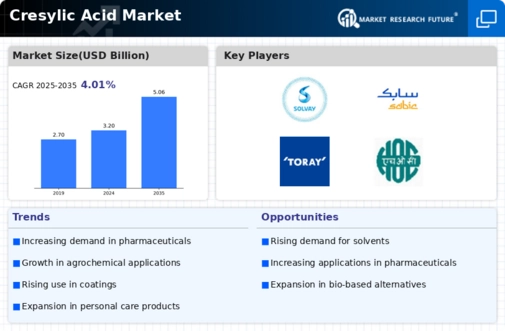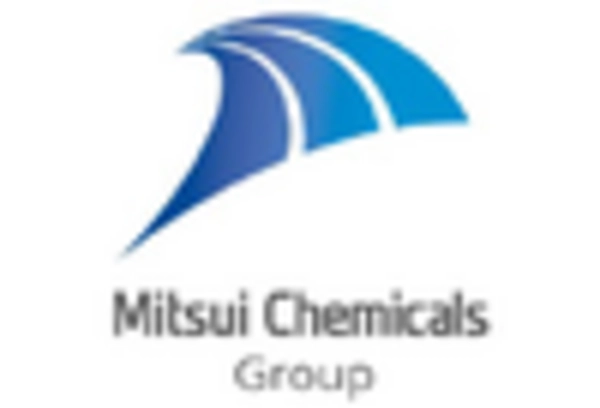Market Growth Projections
The Global Cresylic Acid Market Industry is projected to experience substantial growth over the next decade. With a market valuation of 3.2 USD Billion in 2024, it is anticipated to reach 5.06 USD Billion by 2035, reflecting a CAGR of 4.26% from 2025 to 2035. This growth trajectory suggests a robust demand for cresylic acid across various applications, including pharmaceuticals, agrochemicals, and chemical manufacturing. The increasing awareness of health, safety, and environmental sustainability is likely to further drive market expansion, indicating a promising future for the Global Cresylic Acid Market Industry.
Growth in Chemical Manufacturing
The Global Cresylic Acid Market Industry is poised for growth due to the expanding chemical manufacturing sector. Cresylic acid is utilized in the production of various chemicals, including phenolic resins and surfactants. As industries seek to enhance production efficiency and develop innovative chemical products, the demand for cresylic acid is likely to rise. The market is projected to grow at a CAGR of 4.26% from 2025 to 2035, reaching an estimated value of 5.06 USD Billion by 2035. This trend suggests that the chemical manufacturing sector will continue to be a significant driver for the Global Cresylic Acid Market Industry.
Increasing Demand in Pharmaceuticals
The Global Cresylic Acid Market Industry experiences a notable surge in demand from the pharmaceutical sector. Cresylic acid serves as a vital intermediate in the synthesis of various pharmaceutical compounds, including antiseptics and disinfectants. As the global population ages and healthcare needs expand, the pharmaceutical industry is projected to grow significantly. This growth is reflected in the market's valuation, which is expected to reach 3.2 USD Billion in 2024. The increasing focus on health and hygiene further propels the demand for cresylic acid-based products, indicating a robust future for the Global Cresylic Acid Market Industry.
Rising Applications in Agrochemicals
The Global Cresylic Acid Market Industry benefits from the increasing applications of cresylic acid in agrochemicals. As agricultural practices evolve and the need for effective pest control rises, cresylic acid is utilized in the formulation of herbicides and fungicides. The growing global population necessitates enhanced agricultural productivity, which in turn drives the demand for agrochemical products. This trend indicates a promising outlook for the Global Cresylic Acid Market Industry, as the agrochemical sector continues to expand, potentially leading to increased consumption of cresylic acid in the coming years.
Technological Advancements in Production
The Global Cresylic Acid Market Industry is influenced by ongoing technological advancements in production processes. Innovations in chemical synthesis and processing techniques enhance the efficiency and yield of cresylic acid production. As manufacturers adopt cutting-edge technologies, the cost of production may decrease, making cresylic acid more accessible to various industries. This trend suggests that the market could witness increased competition and diversification of applications. The continuous improvement in production technologies is likely to bolster the growth of the Global Cresylic Acid Market Industry, enabling it to meet the rising demand across multiple sectors.
Environmental Regulations and Sustainability
The Global Cresylic Acid Market Industry faces both challenges and opportunities due to evolving environmental regulations. Stricter regulations regarding chemical emissions and waste management compel manufacturers to adopt more sustainable practices. Cresylic acid, being a versatile compound, can be produced using eco-friendly methods, which may appeal to environmentally conscious consumers. As industries increasingly prioritize sustainability, the demand for cresylic acid produced through greener processes is likely to rise. This shift towards sustainability could reshape the landscape of the Global Cresylic Acid Market Industry, fostering innovation and compliance with regulatory standards.

















Leave a Comment